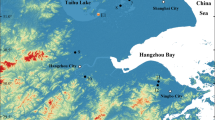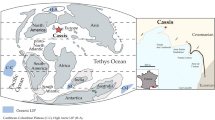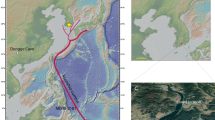Abstract
A pollen spectrum obtained from the Ileret Member of the Koobi Fora Formation indicates that vegetation patterns differed significantly from those prevailing east of Lake Rudolf today. The pollen-bearing sediment, which is interstratified with Plio-Pleistocene hominid fossils, shows somewhat more humid conditions.
This is a preview of subscription content, access via your institution
Access options
Subscribe to this journal
Receive 51 print issues and online access
$199.00 per year
only $3.90 per issue
Buy this article
- Purchase on Springer Link
- Instant access to full article PDF
Prices may be subject to local taxes which are calculated during checkout
Similar content being viewed by others
References
Earliest Man and Environments in the Lake Rudolf Basin: Stratigraphy, Paleoecology and Evolution (edit. by Coppens, Y., Howell, F. C., Isaac, G. L., and Leakey, R. E.), (University of Chicago Press, 1975).
Leakey, R. E., Am. J. phys. Anthrop., 41, 245–250 (1974).
Isaac, G. L., Leakey, R. E., and Behrensmeyer, A. K., Science, 173, 1129–1134
Bowen, B. E., and Vondra, C. F., Nature, 242, 391–393 (1973).
Findlater, I. C., in Earliest Man and Environments in the Lake Rudolf Basin: Stratigraphy, Paleoecologv and Evolution (edit. by Coppens, Y., Howell, F. C., Isaac, G. L., and Leakey, R. E.), (University of Chicago Press, 1975).
Behrensmeyer, A. K., thesis, Harvard University (1973).
Fitch, F. J., Findlater, I. C., Watkins, R. T., and Miller, J. A., Nature, 251, 213–215 (1974).
Curtis, G. H., Drake, R. E., Cerling, T. E., Cerling, B. L., and Hampel, J. H., Nature, 258, 395–398 (1975).
Riollet, G., and Bonnefille, R., Pollen et Spores, XVIII, no. 1, 67–92 (1976).
Findlater, I. C., thesis, Univ. London (1976).
Bonnefille, R., and Vinceus, A., Proc. Tenth INQUA Cong., Birmingham, 1977 (in the press).
Bonnefille, R., in Earliest Man and Environments in the Lake Rudolf Basin. Stratigraphy, Paleoecology and Evolution (edit. by Coppens, Y., Howell, F. C., Isaac, G. L., and Leakey, R. E.), (University of Chicago Press, 1975).
Van Campo, M., in Northeast African and Levantine Pleistocene Prehistory (edit. by Wendorf, F.), (Dallas, 1975).
Cour, P. et al., in 3rd Int. Palyn. Conf. Novosibirsk, USSR (1971).
Wright, H. E., Mcandrews, J. J., and Van Zeist, W., J. Ecol., 55, 415–443 (1967).
Potter, L. D., Schoenwetter, J., and Oldfield, F., in Late Pleistocene of the Southern High Plains (edit. by Wendorf, F., and Hester, J.), (Fort Burgin Research Center, 9, 1975).
Pokrovskaia, I. M., Bull. B.R.G.M.—C.N.R.S., 26, 434 pp (1950).
Author information
Authors and Affiliations
Rights and permissions
About this article
Cite this article
Bonnefille, R. Implications of pollen assemblage from the Koobi Fora Formation, East Rudolf, Kenya. Nature 264, 403–407 (1976). https://doi.org/10.1038/264403a0
Received:
Accepted:
Issue Date:
DOI: https://doi.org/10.1038/264403a0
This article is cited by
-
Genetic Diversity and Population Structure of Acacia senegal (L) Willd. in Kenya
Tropical Plant Biology (2010)
-
Hominid lifestyle and diet reconsidered: paleo-environmental and comparative data
Human Evolution (2000)
-
Did robust australopithecines partly feed on hard parts of gramineae?
Human Evolution (1992)
-
Palaeoclimatic and tectonic implications of Neogene microflora from the Northwestern Ethiopian highlands
Nature (1985)
-
Molluscan biostratigraphy of the Koobi Fora hominid-bearing deposits
Nature (1982)
Comments
By submitting a comment you agree to abide by our Terms and Community Guidelines. If you find something abusive or that does not comply with our terms or guidelines please flag it as inappropriate.



